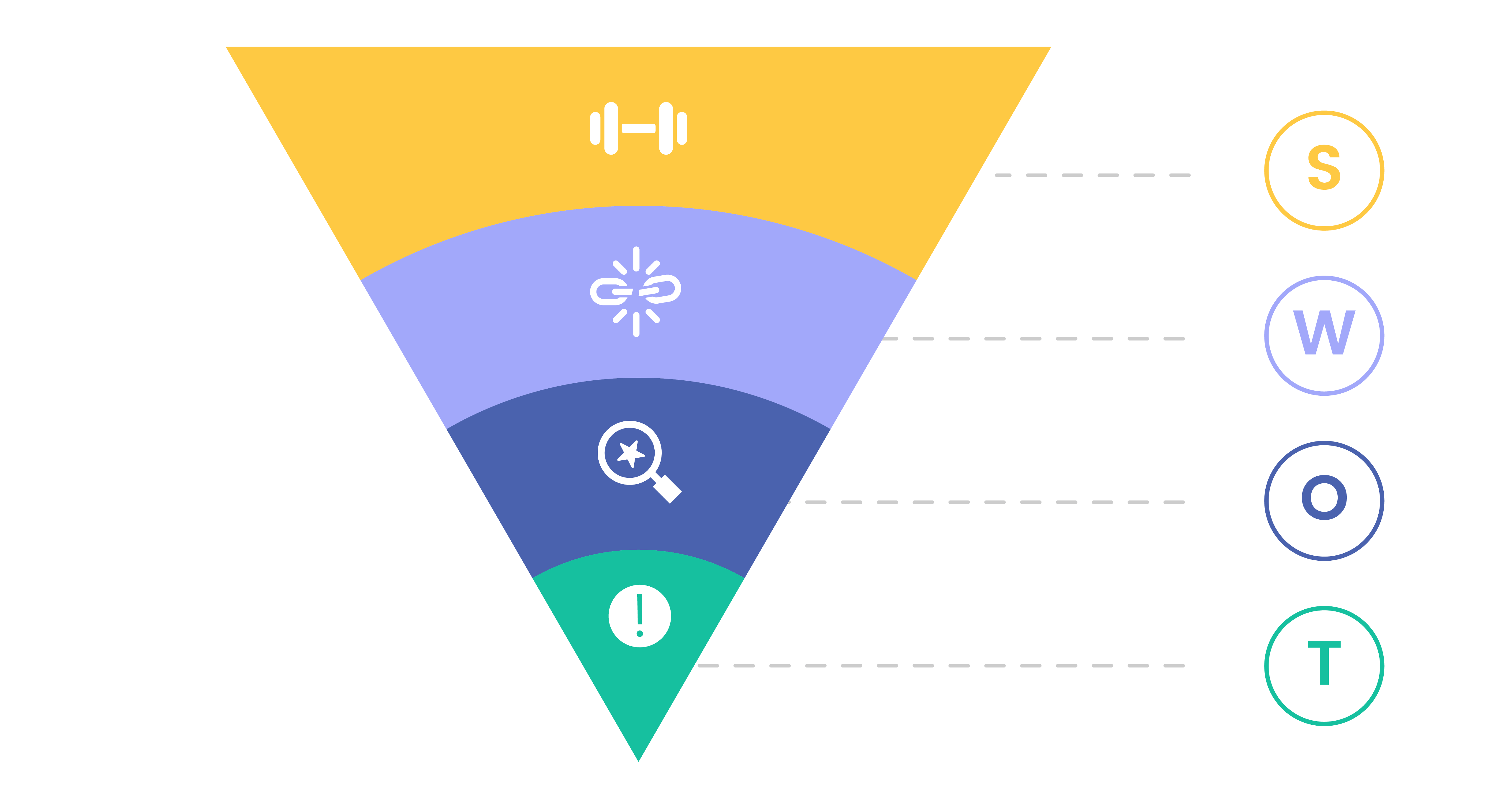What is a SWOT Analysis: Benefits and Examples
Every business owner has to think about the possibility of expanding his business. However, that’s easier said than done, since different aspects can affect the progress or the failure of that expansion. If companies don’t pay attention to particular strengths or potential weaknesses they possess, they may have a problem with business development in the future.
That’s why SWOT analysis is a stage that every business owner should take into account when growing their enterprise.
Table of Contents
- What is a SWOT Analysis?
- What does a SWOT Analysis include?
- Benefits of a SWOT Analysis
- How to Do a SWOT Analysis
What is a SWOT Analysis?
SWOT analysis is an acronym that stands for Strengths, Weaknesses, Opportunities, and Threats. It helps your company to see where it’s at right now, and how to progress in the future by focusing on the aspects that are still not properly developed.
When you decide to commence any type of business action, whether it’s investigating new projects, updating internal regulations, thinking about future possibilities, or changing your strategy mid-execution, you should run a SWOT analysis first.
A SWOT analysis consists of aspects that are both internal and external. This means that you’ll be able to control some factors, while others won’t be as easy to change since they occur outside of your company. Nevertheless, once you’ve identified, noted, and examined as many variables as you can, it will be easier to decide what would be the best course of action.
This Ultimate Guide will cover some of the major benefits that SWOT analysis offers for business development, as well as examples of what to consider if you’re beginning your SWOT analysis.

What does a SWOT Analysis include?
As we’ve previously mentioned, a SWOT analysis consists of several factors. Knowing all members of the acronym can help your business express the components of a plan that need to be acknowledged more successfully.
When you know which aspects of your company need to be upgraded and what outside factors you need to pay attention to, progress comes as a natural reaction to a well-organized plan.
Components of SWOT Analysis
We can separate the components of the SWOT analysis by the division into internal and external factors.
Internal factors
Internal factors primarily refer to assets and skills that are already at your disposal. These are the first members of the acronym, that is Strengths and Weaknesses.
Some usual internal factors include:
- Financial resources (including capital, revenue streams, and investment prospects)
- Physical resources (such as locations, provisions, and equipment)
- Human resources (target audiences, volunteers, and staff)
- Natural resource access, patents, copyrights, and trademarks
- Existing procedures (software systems, corporate hierarchies, and personnel programs)
Strengths
Strengths are those things your company is exceptionally good at or those things that in a way, set it apart from the competition. Consider the benefits that your company offers compared to competing companies. What is something that your business has, and theirs doesn’t?
These could be your employees’ drive, your ability to obtain particular materials, a loyal customer base, a strong balance sheet, unique technology, or a robust set of assembled procedures.
However, you need to pay attention to the other side of the perception, that is what your competitors see as your strength. For example, if your competitive companies offer technology of the best quality, then your possession of high-quality tech isn’t something you should consider as a strength, but rather as something fundamental.
Weaknesses
A company’s weaknesses prevent it from operating at peak efficiency. Aspects of your business that could be identified as weaknesses are all those fragments that pull your company downwards and that need to be improved in several areas for you to stay competitive.
For example, some weaknesses your company could be dealing with are a poor supply chain, a large debt load, a weak brand, or a lack of funding.
Pay attention to your surroundings as well. How does your competition see you? Which parts of your business do they see as weak links? How can you improve? Bear in mind that you have to be honest with yourself for the SWOT analysis to work. If you want to succeed, you need to look deep to find those problems – and solve them.
External factors
Every business, organization, and person is influenced and affected by external pressures. These are the outside factors that we cannot control. They include the last two members of the acronym, Opportunities and Threats.
Here are some examples of the external factors:
- Market trends (including new goods, developments in technology, and changes in audience demands)
- Financial trends (local, national, and worldwide) in the economy
- Finance (from gifts, laws, and other sources)
- Partnerships and supplier relationships
- Economic, and environmental regulations
Opportunities
They often result from circumstances that are outside of your company and call for consideration of potential future events. These could be from advancements in the technologies you employ or the market you service.
The ability to recognize and seize opportunities can have a significant impact on your company’s capacity to stand out and establish leadership in your industry. An example of a business opportunity would be if a rival company closes its doors in an area where you don’t currently do business.
Additionally, you want to keep an eye out for modifications to any government regulations related to your industry. Shifts in population demographics, lifestyles, and social trends can all be seen as intriguing opportunities that you could use for your benefit.
Threats
Threats are all the factors that could potentially harm your company’s success. If we were to imagine that you’re a beekeeper, hard winters could be a potential threat to your business. Some common threats are rising material costs, growing competitiveness, or bad debt.
Always strive to keep these threats under control, before they take advantage of your business’s potential. Consider the challenges you have when bringing your product to market and making sales. You can see that your products’ quality requirements or standards are shifting and that, to keep ahead of the competition, you’ll need to make changes to those products.
It is good to mention that you should constantly be informed about what other companies are doing and how they are progressing. However, keep in mind that you might not want to follow their lead. Therefore, don’t try to imitate their steps unless you know it will help your company in some way.
Benefits of a SWOT Analysis
A SWOT Analysis brings many advantages, especially if you’re a small business owner. Here are some examples of how SWOT analysis can help your small business navigate challenges, capitalize on opportunities, and achieve long-term success:
Identifies Strengths
Your small business can use SWOT analysis to identify its unique strengths, such as a strong brand reputation, niche expertise, loyal customer base, or innovative products/services.
Knowing your business’s strengths allows you to leverage them effectively, differentiate them from competitors, and capitalize on their competitive advantages.
Highlights Weaknesses
Small businesses often face resource constraints, limited budgets, or gaps in expertise. Conducting a SWOT analysis can help in pinpointing these weaknesses.
By acknowledging weaknesses, small businesses can work on improving them, whether it’s through skill development, process optimization, or strategic partnerships.
Spots Potential Opportunities
SWOT analysis is a useful tool for small firms to find possibilities for growth by identifying new customer needs, market trends, and competitive gaps.
It enables them to adapt their products or services or explore new market segments, thereby expanding their customer base and revenue streams.
Anticipates Threats
Companies operate in dynamic environments where threats can arise unexpectedly. SWOT analysis allows them to anticipate potential threats such as new competitors, regulatory changes, or economic downturns.
By identifying threats in advance, your business can develop contingency plans, strengthen its resilience, and mitigate risks to its operations.
Improves Strategic Decision Making
SWOT analysis provides small businesses with valuable insights to make informed strategic decisions. It helps them prioritize initiatives, allocate resources effectively, and align their actions with their business objectives.
It systematically evaluates various factors that influence the business and enables informed decision-making based on a comprehensive understanding of the business’s internal and external environment.
Facilitates Business Planning
For small businesses, especially startups, SWOT analysis can serve as a foundational tool for business planning.
It assists in setting realistic goals, defining strategies, and establishing a roadmap for achieving long-term success.
Improves Communication and Collaboration
SWOT analysis encourages small business owners and stakeholders to collaborate, share perspectives, and align their visions for the company’s future.
It fosters open communication, promotes brainstorming sessions, and facilitates consensus-building around key strategic priorities.
Focuses Resource Allocation
Small businesses often have limited resources, including financial, time resources, or limited staff. SWOT analysis helps them prioritize where to allocate these resources for maximum impact.
By identifying areas of strength and opportunity, small businesses can allocate resources to initiatives that align with their strategic goals, ensuring efficient use of limited resources.
Competitive Positioning
Understanding strengths and weaknesses relative to competitors is crucial for small businesses. SWOT analysis permits your enterprise to assess its competitive positioning within the market.
Also, by analyzing competitor weaknesses and threats, small businesses can identify opportunities to differentiate themselves and gain a competitive edge.
Enhances Marketing Strategies
SWOT analysis provides valuable insights for developing effective marketing strategies tailored to the business’s strengths and market opportunities.
Small businesses can leverage their strengths and capitalize on market opportunities to craft compelling value propositions and targeted marketing messages that resonate with their target audience.
Risk Management
Small businesses face various risks, including financial risks, operational risks, and market risks. SWOT analysis helps them identify and mitigate these risks proactively.
By identifying potential threats and weaknesses, small businesses can develop risk mitigation strategies to minimize the impact of adverse events and safeguard their operations.
Adaptation to Changing Market Conditions
Markets are constantly evolving, and small businesses need to adapt to changing market conditions to remain competitive. SWOT analysis enables small businesses to stay agile and responsive to market dynamics.
By regularly reassessing their strengths, weaknesses, opportunities, and threats, small businesses can adjust their strategies and tactics to capitalize on emerging opportunities and mitigate emerging threats.
Enhanced Business Performance
Ultimately, the primary goal of SWOT analysis for small businesses is to improve business performance and achieve sustainable growth.
By leveraging the insights gained from SWOT analysis, small businesses can make strategic decisions that drive innovation, optimize operations, and enhance overall business performance.

Virtual Assistants as the SWOT Analysis Helping Tool
If you’re applying a SWOT analysis method to your business but have trouble determining which aspects of the analysis need further development, then you should consider hiring a Virtual Assistant to help you apply the SWOT analysis successfully on your business.
Listed below are some of the beneficial aspects VAs can cover to navigate your company’s SWOT analysis the right way.
Strengths:
- Virtual assistants can bring specialized skills and expertise to the table, complementing the strengths of the existing team.
- They can handle repetitive tasks efficiently, freeing time for the core team to focus on strategic activities.
Weaknesses:
- VAs can help mitigate weaknesses by filling skill gaps within the organization. For instance, a VA with relevant skills can be hired if the team lacks expertise in a particular area required for the analysis.
- They can also assist in overcoming resource constraints, such as limited manpower or time, which might hinder the thoroughness of the SWOT analysis.
Opportunities:
- Virtual assistants can help identify new opportunities by conducting market research, competitor analysis, and trend monitoring.
- They can assist in gathering data and information from various sources, enabling the organization to capitalize on emerging trends and market shifts.
Threats:
- VAs can play a crucial role in monitoring threats by keeping track of industry developments, regulatory changes, and competitive actions.
- They can assist in analyzing potential threats and devising strategies to mitigate risks, ensuring the organization remains proactive in its approach.
Employing a virtual assistant can help your business’s SWOT analysis since they can provide a variety of talents, mitigate threats, ease weaknesses, and make opportunity discovery easier.
Get matched with a highly qualified virtual assistant and offload your time-consuming tasks today.
How to Do a SWOT Analysis
A SWOT analysis can be divided into multiple sections with concrete recommendations. The following steps are typically involved in a SWOT analysis.
- Determine Your Objective
While a SWOT analysis is a broader term and can be applied to different things, focusing on a single goal will probably yield greater benefits. When a corporation has a goal in mind, it can make informed decisions about what it wants to accomplish in the end.
For example, your objective for SWOT analysis could be opening a new social media platform that you could use to connect with your ideal clients. The SWOT analysis could help you determine whether this is a good decision for your company.
- Assemble Ideas
The team tasked with conducting the study should start by listing concepts under each of the four SWOT analysis components. This means that every aspect of the SWOT analysis has certain questions that can help the analysis to triumph and show expected results.
These are some of the questions for each component of the analysis:
- (Strength) What is something we are good at?
- (Strength) What is the product that does good on the market?
- (Weakness) Which aspects of the company are undeveloped?
- (Weakness) What services are not as profitable?
- (Opportunities) Which new markets are available?
- (Opportunities) What demographics are we not targeting?
- (Threats) Which competitive companies are in our way?
- (Threats) Which material costs need to be dealt with?
Everyone who participates in this activity should be encouraged to speak their opinions because there is no correct or incorrect response. This step resembles the “white-boarding” concept. Ideas can be discarded later if they end up irrelevant to the analysis, but until then it’s important to think of as many possible questions and answers as possible.
- Organize Findings
When you’ve collected the ideas that might be relevant to your business, then it is time to properly organize them. A corporation can narrow its emphasis to only the best ideas or the biggest threats to the business by honing everyone’s ideas.
Since this stage can cause disagreement among the participants about the urgency and importance of different ideas, it is advisable to include someone from higher in the management hierarchy to determine the quality of the ideas and make the final decision that would be in the company’s best interest.
- Create A Strategy
A concrete plan is the final step of the process. The analysis team members take the list of items that are organized into bullets for each category and combine them to generate a summary plan that provides direction on the initial goal.
For example, let’s say that our team saw the potential in opening a new social media app to get more clients. They concluded that your competitors didn’t upgrade to the next social media app, so you would have the advantage. However, it costs a lot to transfer from the app that you’ve previously used, plus you could potentially lose the clients you already have if they decide that they’re just not interested in that kind of change.
This is where your SWOT analysis comes to light, and shows that this business strategy should be reconsidered or at least postponed until better conditions appear.
Conclusion
Strategic planning and regular company analysis are the greatest ways to monitor development, advantages, and disadvantages. When making decisions, employ SWOT analysis to evaluate and implement strategies more thoroughly and completely.
If you dedicate your time to making the SWOT analysis as detailed and accurate as possible, it will help you enormously in your future business endeavors.










